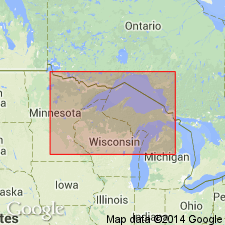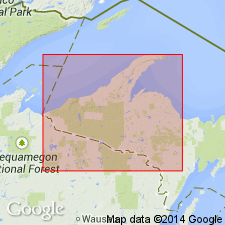
- Usage in publication:
-
- Bijiki schist*
- Modifications:
-
- Original reference
- Dominant lithology:
-
- Schist
- AAPG geologic province:
-
- Lake Superior region
Summary:
Pg. 596. Bijiki schist. Peculiar schist with some quartzites. Thickness 520 feet. Present in Marquette district. Equivalent in age to Goodrich quartzite of western part of Marquette district. Age is Precambrian.
Named from typical exposures near mouth of the Bijiki River, near easternmost part of Lake Michigamme, in sec. 25, T. 48 N., R. 30 W., Marquette iron-bearing district, Northern Peninsula, northwestern MI.
[GNC remark (ca. 1938): Later reports by C.R. Van Hise and others stated that Bijiki schist overlies Goodrich quartzite, and assigned it to upper Huronian. (See USGS Bull. 360, 1909, and USGS Monograph 52, 1911.)]
Source: US geologic names lexicon (USGS Bull. 896, p. 188); supplemental information from GNU records (USGS DDS-6; Denver GNULEX).

- Usage in publication:
-
- Bijiki iron-formation member*
- Modifications:
-
- Revised
- AAPG geologic province:
-
- Wisconsin arch
Summary:
Changed name to Bijiki iron-formation member and included it in Menominee slate. Age is pre-Cambrian (upper Huronian).
Source: US geologic names lexicon (USGS Bull. 896, p. 188).

- Usage in publication:
-
- Bijiki iron-formation member*
- Modifications:
-
- Revised
- AAPG geologic province:
-
- Lake Superior region
Summary:
Pg. 36. Bijiki iron-formation member of Michigamme slate of Animikie series. Lower part of Michigamme slate in Marquette district, northwestern Michigan, includes Bijiki iron-formation, Clarksburg volcanics, and Greenwood iron-formation members. Age is Precambrian (Animikie Series).
Source: US geologic names lexicon (USGS Bull. 1200, p. 343).

- Usage in publication:
-
- Bijiki Iron-Formation Member*
- Modifications:
-
- Overview
- AAPG geologic province:
-
- Lake Superior region
Summary:
Pg. 2845 (fig. 2, stratigraphic chart compiled from Leith and others, 1935; James, 1958; Gair and Thaden, 1968). Bijiki Iron-Formation Member of Michigamme Slate of Baraga Group of Marquette Range Supergroup (new; replaces †Animikie series of James, 1958, south of Lake Superior, in Michigan and Wisconsin). Present in Marquette Range, northwestern Michigan. Overlies Clarksburg Volcanics Member of Michigamme Slate. Age is middle Precambrian.
Source: Publication.
For more information, please contact Nancy Stamm, Geologic Names Committee Secretary.
Asterisk (*) indicates published by U.S. Geological Survey authors.
"No current usage" (†) implies that a name has been abandoned or has fallen into disuse. Former usage and, if known, replacement name given in parentheses ( ).
Slash (/) indicates name conflicts with nomenclatural guidelines (CSN, 1933; ACSN, 1961, 1970; NACSN, 1983, 2005, 2021). May be explained within brackets ([ ]).

